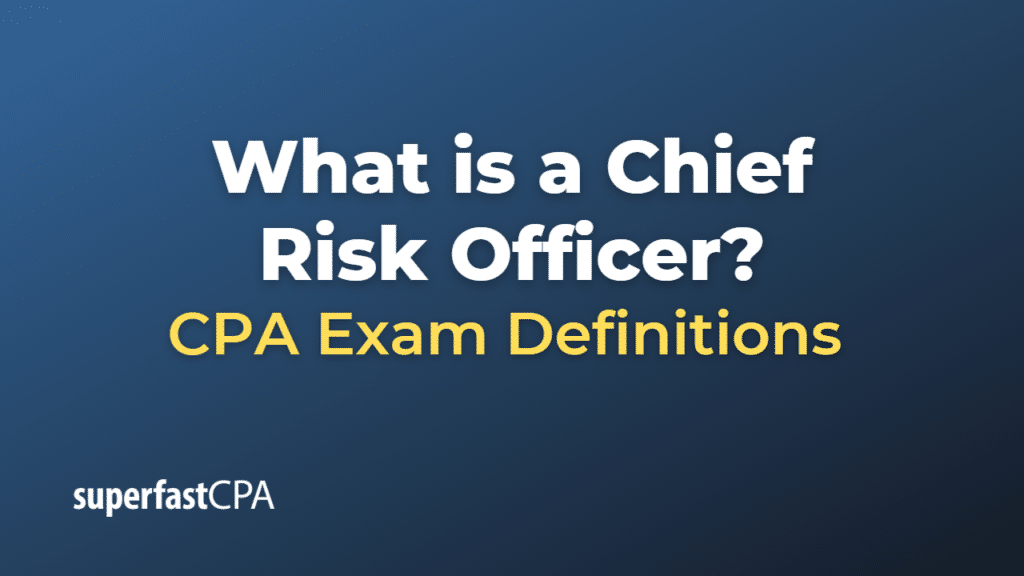Chief Risk Officer
A Chief Risk Officer (CRO) is a senior executive responsible for identifying, assessing, and managing risks across an organization. The CRO’s primary objective is to ensure that the organization has a comprehensive and effective risk management framework in place to minimize potential threats and adverse impacts on its operations, reputation, and financial performance. The role of the CRO is particularly crucial in highly regulated industries such as banking, insurance, and financial services, where organizations face various risks, including credit risk, market risk, operational risk, and regulatory risk.
Key responsibilities of a CRO typically include:
- Risk identification and assessment: The CRO is responsible for identifying and assessing the various risks the organization faces, including financial, operational, regulatory, strategic, and reputational risks.
- Risk management framework: The CRO develops and implements a comprehensive risk management framework, including policies, procedures, and controls, to effectively manage and mitigate risks across the organization.
- Risk appetite and tolerance: The CRO works with the board of directors and senior management to establish the organization’s risk appetite and tolerance, defining the level of risk the organization is willing to accept to achieve its strategic objectives.
- Risk monitoring and reporting: The CRO regularly monitors the organization’s risk exposure and reports to the board of directors and senior management on the effectiveness of the risk management framework, any significant risks or emerging threats, and recommended actions to address them.
- Risk culture: The CRO promotes a strong risk culture within the organization, ensuring that risk awareness and management are embedded in the decision-making processes and everyday activities of employees at all levels.
- Regulatory compliance: The CRO ensures that the organization complies with all relevant regulations and standards related to risk management and works with regulators to address any issues or concerns.
- Crisis management and business continuity: The CRO plays a crucial role in the organization’s crisis management and business continuity planning, ensuring that the organization is prepared to respond effectively to adverse events and minimize their impact on its operations and reputation.
The role of the CRO may vary depending on the size, complexity, and industry of the organization. In smaller organizations, the CRO may be responsible for managing all aspects of risk management, while in larger organizations, they may lead a team of risk professionals specializing in different areas, such as credit risk, operational risk, or regulatory risk.
Example of a Chief Risk Officer
Let’s consider a fictional bank called “SafeBank.” The bank has recently appointed John Doe as its Chief Risk Officer (CRO). Here’s an example of how John might fulfill his role as the CRO of SafeBank:
- Risk identification and assessment: John identifies and assesses various risks facing SafeBank, including credit risk, market risk, operational risk, and regulatory risk. He works with his team to analyze the potential impacts of these risks on the bank’s financial performance, operations, and reputation.
- Risk management framework: John develops a comprehensive risk management framework for SafeBank, including risk policies, procedures, and controls. He ensures that these policies are implemented consistently across the organization and regularly updated to reflect changes in the risk environment.
- Risk appetite and tolerance: John collaborates with the bank’s board of directors and senior management to define SafeBank’s risk appetite and tolerance levels, ensuring that the bank’s risk-taking activities align with its strategic objectives and regulatory requirements.
- Risk monitoring and reporting: John regularly monitors SafeBank’s risk exposure and the effectiveness of its risk management framework. He reports to the board of directors and senior management on the bank’s risk profile, any significant risks or emerging threats, and recommends actions to mitigate these risks.
- Risk culture: John promotes a strong risk culture within SafeBank by conducting training sessions, providing guidance to employees on risk management best practices, and reinforcing the importance of risk awareness and management in their daily activities and decision-making processes.
- Regulatory compliance: John works closely with regulators to ensure that SafeBank complies with all relevant risk management regulations and standards. He addresses any regulatory concerns or issues promptly and effectively.
- Crisis management and business continuity: John oversees SafeBank’s crisis management and business continuity planning, ensuring that the bank is well-prepared to respond to adverse events, such as a cyberattack, natural disaster, or financial crisis, and minimize their impact on its operations and reputation.
In this example, John plays a crucial role in managing and mitigating risks at SafeBank, ensuring that the bank’s risk management framework is robust and effective, and that its risk-taking activities align with its strategic objectives and regulatory requirements. His leadership in risk management helps to protect SafeBank’s financial stability, reputation, and long-term success.













